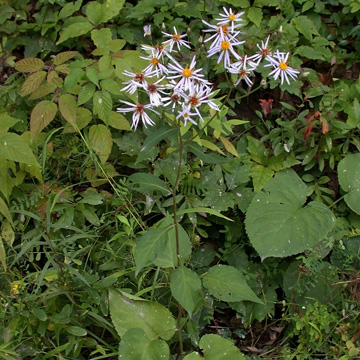

Eurybia macrophylla - (image 1 of 6)
Taxonomy
Family: Asteraceae
Synonymous with Aster macrophyllus L.
Habitat
Woods.
Associates
Distribution
Nova Scotia, New Brunswick and Quebec west to WI, MN, and southeast Manitoba, south to PA and KY, and in mountains to GA.
Morphology
Perennial 20-120 cm, colonial by creeping rhizomes, with many clusters of basal leaves on short, sterile shoots; glandular at least in the inflorescence and otherwise glabrous or rough-hairy. Leaves thick, firm, crenate or serrate with mucronulate teeth; basal and lower caudate leaves cordate, to 30 cm long, short-acuminate to obtuse, long petiolate, upper leaves becoming progressively or abruptly reduced, less cordate and with shorter petioles. Inflorescence corymbiform, with few and often broad bracts; involucre 7-11 mm, glandular or short-hairy; bracts firm, imbricate, appressed, rounded to sharply acute; outer involucral bracts to 2.5 mm wide and rarely more than 2.5 times as long; ray petals 9-20, 7-15 mm, pale lilac or purple.
Notes
Flowers: late July to early October
Wetland indicator: Upland
The large, heart-shaped leaves can occur in large patches at the edge of woodlands.
References
Gleason, Henry A. and A. Cronquist. 1991. Manual of Vascular Plants of
Northeastern United States and Adjacent Canada. Second Ed.
The New York Botanical Garden. Bronx, NY
Swink, F. and G. Wilhelm. 1994. Plants of the Chicago Region.
Indiana Academy of Science. The Morton Arboretum. Lisle, Illinois.
|
Michael Hough © 2009 |